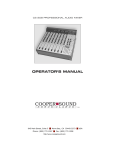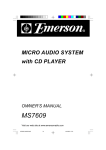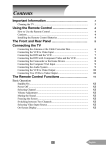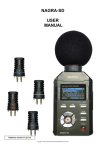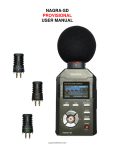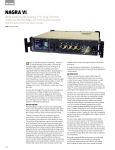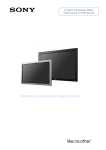Download Cooper Sound CS 208 V2 Operator`s manual
Transcript
CS 208 V2 PROFESSIONAL AUDIO MIXER OPERATOR’S MANUAL 645 Main Street, Suite C ■ Morro Bay, California ■ (805) 772-1007 ■ Fax (805) 772-1098 www.coopersound.com CS 208 v2 Cooper Sound Systems, Inc. TABLE OF CONTENTS INPUT CHANNEL DESCRIPTION.............................................................................1, 2 OUTPUT MODULE DESCRIPTION ..........................................................................3, 4 REAR PANEL DESCRIPTION .......................................................................................5 PIN OUTPUTS ...............................................................................................................6 STEREO MODULE (OPTIONAL) ..............................................................................7, 8 SPECIFICATIONS GENERAL ......................................................................................................................9 INPUTS ........................................................................................................................10 OUTPUTS.....................................................................................................................11 BLOCK DIAGRAM - INPUT & POWER WIRING.........................................................12 BLOCK DIAGRAM - OUTPUT .....................................................................................13 EQ CHARTS ................................................................................................................14 LAYOUT - A,B,C...........................................................................................................15 LAYOUT - D,E,F...........................................................................................................16 LAYOUT - G,G PPM, H, MB ........................................................................................17 CSST BLOCK DIAGRAM & LAYOUTS........................................................................18 BASIC SET UP & METERING ...............................................................................19, 20 OPERATION & APPLICATION NOTES ...................................................21,22,23,24,25 APPLICATION NOTES AN 1 v2 ROLLS............................................................................................................26 AN 2A INPUT CHANNEL OPTIONS ............................................................................27 AN 2B v2 INPUT CHANNEL OPTIONS.......................................................................28 AN 2C v2 INPUT CHANNEL OPTIONS.......................................................................29 AN 2D v2 INPUT CHANNEL OPTIONS.......................................................................30 AN 2E v2 INPUT CHANNEL OPTIONS.......................................................................31 AN 3 v2 COMMUNICATIONS IN .................................................................................32 CABLE WIRING ...........................................................................................................33 GENERAL NOTES .......................................................................................................34 ADC OPTION - INSTRUCTIONS.................................................................................35 ADC OPTION - SPECIFICATIONS..............................................................................36 WARRANTY .................................................................................................................37 INPUT MODULE MODEL CS 208 v2 Left Section 1. CH: Channel Power (down = on) Do not switch during recording. 2. PH/DYN/T: Phantom power, no mic power, T (AB) power (Phantom power is normally 48 v, see layout A to change to 12 v). 3. ø: Phase (audio only). ø = normal phase, REV = reverse phase 4. Mic/Line: Microphone or line level in. 5. Pad: Attenuator to reduce either mic or line input levels. 6. HP 1: High pass filter, pre-transformer. 7. HP 2: High pass filter, post transformer & preAmps. 8. EQ: Equalizer bypass. Affects HF, MF & LF filters, not HP filters. 9-12. A,B,C,D: Channel to mix bus assigns. L(left), R(right) indicate monitor & pan pot assignment. 13. LIM+LED: The limiter is a symmetrical peak detecting type & is completely out of circuit when switched off. Threshold: See (15). Attack & release times are preset internally (see layout A to change). The LED indicates limiter action. 14. PFL/AFL+LED: Pre fade listen or After fade listen (post fader). The switch is not momentary, the LED serves as warning that PFL or AFL is selected. 15. Thres. Limiter threshold. Clockwise = lower threshold. 16.O/L Near overload indicator. 1 MAY 2003 INPUT MODULE MODEL CS 208 v2 Right Section 17. Gain: Mic/Line preamp gain. 18. HF: High frequency amplitude control. 19. MF 500, 5k Mid-frequency select. 20. MF: Mid-frequency amplitude control. 21. N/S: N = normal, S = side for M/S decoding. ‘S’ inverts phase to B & D busses allowing one pair of channels to be used with a M/S mic configuration and decoded to a L/R stereo signal (this is an option, see separate application note). 22. LF: Low frequency amplitude control. 23. PF/AF: Selects pre or after fader for Aux 1 send. 24. A1: Aux 1 send (the aux sends are not affected by the ABCD mix bus switches). 25. PF/AF: Selects pre or after fader for Aux 2 send. 26. A2: Aux 2 send. 27. Pan (switch): Switching the pan switch to the left disengages the panpot. Crosstalk is therefore minimized and the output levels will remain equal. 28. Pan (pot): (L) = A & or C (R) = B & or D 29. Channel fader 2 MAY 2003 OUTPUT MODULE MODEL CS 208 v2 Monitor 2 & 3 1. DIR/TAPE: Selects direct or tape return signals (for busses ABC & D). 2-7. A,B,C,D,A1,A2: Assigns busses to Monitor 2/3 outputs (L) = left, (R) = right when using stereo headphones. 8. M/ST/MS: M = mono, ST = stereo, MS = mid-side. Only applicable if stereo headphones are used. (See rear panel) 9. LEVEL: Gain Adjustment. Aux 1, Aux 2 10,11.: Aux 1 & 2 master level controls. 12. BNC: 12 volts available to power a ‘Littlite’® (See meter panel). 13. RETURNS: Trim pots (multiturn) to adjust return (tape) level to Monitors 1, 2 & 3 and the meters. Meter Section 14. AUX/CD Meters 3, 4 = CD or Aux outputs (3 = C or A1, 4 = D or A2). 15. PFL: Meters 1, 2 can indicate PFL selected on the input channels (momentary switch). 16. TAPE/DIR: Tape/Direct. Meters indicate the return signals. (1 = A, 2 = B, 3 = C, 4 = D). CD/Aux switch (14) overrides the tape return. Monitor 1 Section 17. COMM: Communications return (talkback) to Monitor 1 only (See appl. note for 2 returns). The multiturn trimmer below this switch adjusts the level. 18. PL 1: Private line assign to Monitor 1 (down = on). See master PL switch #28. 19. TAPE/DIR: Tape or Direct to Monitor 1 3 MAY 2003 OUTPUT MODULE MODEL CS 208 v2 20. SOLO/OFF/ON A,B,C,D,A1,A2: 21. M/ST/MS: (Monitor 1) Any combination of busses can be monitored. ’SOLO’ disconnects the otherbusses to the Monitor 1 output - Solo normally mono’s the signal to the headphone out - there is an internal slide switch to defeat this. ‘ON’ - In stereo mode the busses are assigned to either (L) left or (R) right. M = mono, ST = stereo, MS = mid-side Any combination selected by switch (20) can be monitored in mono, stereo or mid-side. 22. LEVEL: (Monitor 1) Gain control. 23. MIC: Internal slate mic (See #24, 25, 27). OSC/SL SECTION 24. AB/CD/AUX: 25. EXT SLATE: Assigns the oscillator or slate to AB,CD or Aux busses- The aux. bus switch now has 3 positions. Left = off, Center = Aux 1 only, Right = Aux 1 & 2. Down = external slate mic input (on rear panel). The trimmer below adjusts the slate mic level. OSCILLATOR SECTION 26. 10k/1k/100: Frequency select for the internal oscillator. LEVEL: Adjusts oscillator level (multiturn). OSC: Internal oscillator - Up = on, Down = momentary on. 27. SL: Slate mic; Down = with LF (low frequency) tone. Up = no LF tone. 28. PL SECTION: Master private line to Monitors 1, 2 or 3. The level is adjusted by the multiturn trimmer above. 2/+/3: 29. ROLL 1,2: Assigns PL to Monitor 2, 2 & 3 or Monitor 3 only. Independent remote control for many types of recorders (see separate application note). 30. MASTER FADERS: ABCD - Normally left at maximum for optimum headroom and signal to noise ratio. 4 MAY 2003 REAR PANEL LEFT TO RIGHT MONI 2, MONI 3: MODEL CS 208 v2 Monitor 2 & 3 outputs - for stereo or mono headphones (or mono wireless communications). FUSE: 2.5 A (5 x 20 mm). EXT POWER: Pin 1 = negative DC, Pin 3 = Battery charge (positive), Pin 4 = Positive DC (see specifications). AES OUTS (Option) Digital outputs for A,B,C,D busses. Clock reference in (upper BNC). Clock reference out (lower BNC) UNBALANCED OUTS(TQG): A,B,C,D Pin 1 = ground, Pin 2 = signal. UNBALANCED OUTS(DB9): A,B,C,D. BALANCED OUTS(XLR): A,B,C,D, Aux 1, Aux 2. ROLL 1 & 2: Remote control for various recorders. MIX BUS IN: A,B,C,D (current input). COMM IN: Communications input to Monitor 1 (balanced). SL IN: External slate mic input. RETURNS: A,B,C,D, balanced inputs. BAL PREFADE OUTS(Option): Pre or post fader channel outputs (+4dBU balanced) for multitrack recording (standard wiring). DIR OUTS: Channel direct outs, post fader (unbalanced). INSERTS: Can be changed to direct out, prefade (unbalanced). See Board A layout. XLR Inputs: Transformer balanced (mic or line level). 2 spare holes: Stereo input channel option. 5 MAY 2003 PIN OUTS MODEL CS 208 v2 All XLR’s are wired pin 2 high. XLR 3M Insert Pin 1 = Ground Pin 2 = High Pin 3 = Low 1/4” stereo jack Tip = Send Ring = Return Sleeve = Ground or direct out, prefader (see appl. note AN 2A & 2B v.2) Direct Out (post fader) 1/4” mono jack Phones 1, 2, 3 1/4” stereo jack (max load = 25Ω per channel) Tip = Left Ring = Right Sleeve = Ground Comm. In. Tip = Signal Sleeve = Ground XLR 3F Pin 2 = High Pin 3 = Low Pin 1 = Ground (See application note AN 3 v.2 for multiple inputs) Mix Bus in DB9 1 =Ground 2=D 3=C 4=A 5=B (current input, see specifications) Outputs DB9 1 2 3 4 5 = Ground =A =B =C =D TQG 3M Pin 1 = Ground Pin 2 = Signal Pin 3 = N/C TQG 5M (roll) (See application note AN 1 v.2) Pin Pin Pin Pin Pin 1 2 3 4 5 = = = = = -10 v (Nagra) Stop (Nagra) Pause/Stop (DATs) Common (DATs) Record (DATs) Returns XLR 3F Pin 2 = High Pin 3 = Low Pin 1 = Ground Ext. Slate in XLR 3F Pin 2 = Signal Pin 3 & 1 = Ground DB25 Balanced Outputs (Option) Pin Pin Ch.1 Hot 24 Ch.5 Hot 18 Cold 12 Cold 6 Ground 25 Ground 19 Ch.2 Hot 10 Cold 23 Ground 11 Ch.6 Hot Cold Ground 4 17 5 Ch.3 Hot 21 Cold 9 Ground 22 Ch.7 Hot Cold Ground 15 3 16 Ch.4 Hot 7 Cold 20 Ground 8 Ch.8 Hot Cold Ground 1 14 2 6 MAY 2003 MODEL CS 208 v2 CSST-STEREO MODULE Overload indicator. 7 MAY 2003 CSST-STEREO MODULE MODEL CS 208 v2 -83 dBu (Z = 1.4kΩ) +28 dBu -40 dB Zin≈10kΩ -15 dB Zin≈600Ω -55 dB Zin≈10kΩ EIN (20 - 20 kHz,150Ω) 8 MAY 2003 SPECIFICATIONS MODEL CS 208 v2 General: (0 dBu ≈ .775v RMS) Dimensions 16.5” x 15.2” x 5” (419 x 386 x 127 mm) Weight with no batteries with alkaline cells 19 lbs. (8.6 kg) 23lbs. (10.4 kg) Overall distortion (THD + N) < 0.01% (0.003% typ.) Equivalent input noise (150Ω 20-20kHz) (150Ω ‘A’ WT’D) -129.5 dBu -131.2 dBu Power Requirements: External: 10v - 25v operating range. Consumption with all channels on is ≈ 630 mA at 12v DC < 8 watts (410 mA at 18v DC) Estimated battery life with 12v, 8 AH lead acid battery > 10 hours. 12v, 12 AH lead acid battery > 15 hours. 18v, 14 AH alkaline cells > 15 hours. (Ni-CAD D cells are ≈ 1/3 the capacity of alkaline cells.) XLR - 4M: 1 = Ground (-) 2 = N/C *3 = Battery charge (+) 4 = External in (+) * Do not connect if rechargeable batteries are not installed. Internal Power: 12 ‘D’ alkaline cells Battery test: + 18v DC = + 12v DC = + 10.5v DC= BNC light: Power on LED: Power cut off voltage: 48v Phantom: 12v T: +12v out, 500 mA max. (1815 bulb ≈ 180 mA). Turns off when the voltage is 11v or less. ≈ 10v DC (internal supply switches off). 48v +/- 1v. 12v +/- 1v. PPM +2 -6 -8 VU +3 0 -1 Nordic Full Scale (Last mark) +4 +2 9 MAY 2003 SPECIFICATIONS MODEL CS 208 v2 System Power Connections and Precautions: RE: (+) chassis equipment. The Nagra must have a separate supply, with no common power supply connections to the mixer or other (-) chassis equipment. Input: Reference: Mic In: -8PPM, 0VU (XLR’s are pin 2 high). (Transformer balanced) Minimum input level Maximum input, line position (no pad) -83 dBu (Z in 1.4k Ω) +28 dBu (Z in 10k Ω) Pad Mic/Line Combined Z in ≈ 600Ω Z in ≈ 10kΩ Z in ≈ 10kΩ 15 dB 40 dB 55 dB High Pass Filters: Hp 1 Pre - transformer Hp 2 Post - transformer & pre Amp. 100Hz -6 dB/oct. 70Hz -12 dB/oct. EQ: High frequency Mid frequency Low frequency +/- 12 dB @ 10 kHz +/- 15 dB 500 - 5 kHz +/- 12 dB @ 100 Hz Insert: Send/direct out, pre-fader -11 dBu Zout = 47Ω (+4 dBu with boost) Return -11 dBu Zin ≈ 5kΩ Direct out (post-fader): -8 dBu Zout = 47Ω O/L indicator: -3 dB MOL Limiter: Threshold Attack Release Variable* -6 PPM to M. O. L. (+4 PPM typ.) 1 ms 150 ms (M. O. L. = maximum output level = 25 dBu on XLR outs, +19 dBu on unbalanced outs.) Pan pots: Center = -3 dB All specifications are measured with the pan pots panned either L or R. 10 MAY 2003 MODEL CS 208 v2 SPECIFICATIONS Output: Reference -8 PPM, 0VU (XLR’s are pin 2 high) XLR balanced outputs: A, B, C, D & Aux. 1, 2 +4 dBu, Zout ≈ 100Ω TQG & DB 9 unbalanced outputs: (ABCD) -2 dBu, Zout ≈ 100Ω Phones 1 out: 0 dBu no load 0 dBu 60Ω load Phones 2 &3: -3 dBu no load -8 dBu 60Ω load Maximum load is 25Ω for each output: Tape return (balanced) -14 dBu to + 19 dBu Zin = 10kΩ Communication in (balanced) -14 dBu to + 19 dBu Zin = 10kΩ Ext. slate in (unbalanced) -60 dBu to - 38 dBu Mix bus in - current input - R. series 10kΩ -8 dBu (-10 dBV) 20kΩ -2 dBu 40kΩ +4 dBu (needs series resistors) Zin = 5kΩ Signal (M. O. L.) to noise of output section: (Dynamic range) (Channel faders off, masters at max) -115 dB 20-20 kHZ Slate subtone 27 Hz (at -16 PPM, -8vu) 11 MAY 2003 MODEL CS 208 v2 BLOCK DIAGRAM INPUT & POWER 12 MAY 2003 BLOCK DIAGRAM MODEL CS 208 v2 MONITOR & OUTPUT 13 MAY 2003 MODEL CS 208 v2 EQ CHARTS 14 MAY 2003 LAYOUTS MODEL CS 208 v2 15 MAY 2003 MODEL CS 208 v2 LAYOUTS 16 MAY 2003 LAYOUTS MODEL CS 208 v2 17 MAY 2003 MODEL CS 208 v2 CSST - LAYOUTS 18 MAY 2003 Basic SET-UP & METERING MODEL CS 208 v2 OPERATING GUIDELINES . 19 MAY 2003 MODEL CS 208 v2 BASIC SET-UP Nominal value of 47kΩ to 56kΩ in series with signal conductors. 20 MAY 2003 OPERATIONAL & APPLICATION NOTES MODEL CS 208 v2 Inputs: XLR In: Transformer balanced input. Nominally Pin 2 high. (Pin 3 - low, Pin 1 - ground). Channel Power: To conserve current consumption, switch off unused channels. Do not switch during recording. Mic Power Select: Mic power off. For example, dynamic and radio microphones. T-power / AB power = Unbalanced microphone powering, nominally Pin 2 is positive, for use with unmodified European microphones. XLR must be reversed for ‘red dot’ microphones. Phantom power = Balanced powering, positive DC voltage on both Pins 2 and 3, normally set for 48v (See application note AN 2C v.2). Do not switch to 48 volt with 12 volt phantom microphones. Phase: This affects audio phase only (ie: does not control the T-power polarity). N (normal) = Pin 2 high. R (reverse). It is important that the phase of the microphones are matched to avoid phase cancellation. Absolute phase throughout the system should also be maintained. Mic / Line: Up = Mic, Down = Line. 40 dB pad. Pad: 15 dB pad, effective in both mic and line positions. For typical SPL (sound pressure levels) pads are not necessary due to the high system headroom. The use of pads will degrade the signal to noise ratio if used within the range of the microphone gain trim. 40 dB pad may be used for balanced line level signals. HP1: Pre transformer filter (100 Hz, 6 dB/oct) for use where very high level, low frequency signals may saturate the transformer and pre-amplifier. In general, because of the very high saturation point of the Jensen Transformers (-6 dBu at 20 Hz), this filter is rarely necessary. HP2: Is a post preamp filter. (70 Hz, 12 dB/oct) Sharp roll-off below 70 Hz to reduce microphone handling noise and other low frequency disturbances. It is recommended to use this for dialogue recording as the bandwidth of interest normally exceeds 100 Hz. EQ: Hard bypass switch does not affect H.P. filters. EQ-H.F. = (High frequency , shelving response) Used to increase / decrease ‘brightness’ of signal. (eg: to reduce sibilance.) EQ-M.F. = (Mid frequency) Center frequency variable from 500-5 kHz. (eg: May be used to increase ‘presence’) EQ-L.F. = (Low frequency, shelving response), may be used for a more gradual tapering of low frequency signals. ABCD: Assigns channel to ABCD mix busses. ‘L’ & ‘R’ indicate pan pot and monitor assignment. 21 MAY 2003 MODEL CS 208 v2 OPERATIONAL & APPLICATION NOTES Limiter: Attack and release times are preset internally. Threshold: Limiter threshold adjustment. (See application note AN 2D v2) The LED adjacent to the limiter switch indicates limiter action. PFL/AFL: Selects prefade listen or after (post) fade listen. All other inputs to monitor 1 will be disconnected (except private line and communication in). The LED indicates whether PFL or AFL is selected as the switch is not momentary. Use ‘PFL’ in the meter section to indicate levels. Aux 1, 2: PF = Pre-fader, AF = After-fader. A separate mix may be made using these busses. Levels are matched pre / post with the channel fader at ‘0’. Master gains are on the output module. Note: Insure that unused channel auxiliary pots are set at minimum. Channel Fader: For optimum headroom and versatility it is best to operate the channel fader around the zero point. Therefore, the microphone preamp gain trim should be adjusted during rehearsals with the channel fader at ‘0’ so that the average program level will modulate the meter to ‘0’ dB. During the take, the channel fader may be used for controlling the channel gain. O / L LED: Nominally set for 3 dB below M. O. L. (Maximum output level) with the channel fader at ‘0’. Occasional flash of the indicator on peaks is not a problem. If the indicator is consistently on, microphone preamp gain should be reduced. N/S: Optional decode circuit for M/S mic configurations. (See application note AN 2E v.2) N = normal, S = side - If the circuit is not installed the switch should be left in the N position. Pan Pot & Switch: Switching the pan switch to the left disables the pan pot. (Crosstalk is therefore minimized and the output levels will remain equal.) 22 MAY 2003 OPERATIONAL & APPLICATION NOTES MODEL CS 208 v2 Insert: Post HP filters, EQ. & Limiter. Send and return to auxiliary equipment. (eg: Outboard compressor / limiter, equalizers and multi-track recorders). Can be changed to Direct out, Prefader only. (See application note AN 2A & 2B v.2) Direct Out: Post channel fader. (eg: feed to playback systems. Direct feed to multi-track recorders) See balanced out option for pre or post fader outputs. 2 Holes above Ch. 1 & 2 on rear panel: Machined for XLR connectors. (eg: stereo input channels) (General: All internal jumpers are mechanical, do not require soldering.) Output Section: 4 main + 2 aux outs. SL (slate): Down = Slate + 27 HZ LF tone. For slating takes where a LF tone is desired. The tone is set at -16 dB on the PPM meters. When the takes are played back at high speed, the LF tone becomes audible to indicate the front end of recorded takes. Internal trimmer adjusts this LF tone level. Up = no LF tone. (Slate to outputs assigned by AB, CD, Aux. switches). Osc. (oscillator): Level set by trimmer above this switch. Frequency is selected by a toggle switch above the level trimmer. Ext. Slate: Up = Internal, Down = External. (see rear panel.) Slate amp. level controlled by trimmer below this switch. Roll 1, 2: Center off switches. Can independently control recorders, depending on the pins selected on the roll connectors on the rear panel. (See application note AN 1 v.2) Up = Record Down = Stop, pause. PL 2 & 3: (private line) Assigns private line to monitor 2 or 3 only or both (center position). Level controlled by trimmer below the switch. AB, CD, Aux: Assigns slate and oscillator to these outputs. There is an option to further split the oscillator and slate feeds to either Aux 1 only or Aux 1 and Aux 2. Mic: Internal slate mic. Monitor 1 Section: Main phones out, two jacks are provided on front panel. Solo, Off, On Any combination of busses can now be monitored. Selected busses can be monitored in mono, stereo or M/S. To facilitate checking of busses, it is recommended to assign the main monitor requirements to the ‘on’ position and spot check by soloing the other inputs. This is quicker than assigning the mains to solo as there is no need to switch off the other busses. Note: ‘On’ function - when more than two busses are selected, the signal level will increase to the headphones. Turn down phones level if necessary - especially when using the line up tone (osc.). 23 MAY 2003 MODEL CS 208 v2 OPERATIONAL & APPLICATION NOTES T/D (tape, direct): Tape return to monitor 1. Comm. in: Comm. return level controlled by trimmer below. ‘PL’: Assigns PL to monitor 1 (Down = on) Phones select: M = Mono ST = Sereo MS = Mid Side Monitor pots 1, 2, 3: To adjust level to phones 1, 2, 3 (stereo output). Caution: It is recommended to set the ‘phones’ pot at minimum before wearing headphones. Then increase the level to suit personal preference. The minimum total load (impedance) per side is 25Ω. The (2) phones 1 jacks are in parallel, the combined load should not be less than 25Ω. Meters Section: Tape/Dir.: Tape, Direct to the meters Meters 1, 2: Monitor AB channels (tape or direct) or PFL. Meters 3, 4: Monitor either CD (tape or direct) or A1, A2. (Also, Meter 4 can indicate the battery level. See meter bridge) PFL momentary switch: Meter 1 & 2 monitor the PFL signal selected on the input channels. VU Meter: Responds to the average program level. The internal oscillator should be set for ‘0’ VU on the meter. This will correspond to +4 dBu on the XLR outputs. As this is an average responding meter, the peak program level will not be indicated. In general, the Nagra modulometer will indicate approximately ‘0’ dB for peak levels if the line up tone is set at -8 dB modulometer. For feeding external equipment with VU meters, the level should be set for ‘0’ VU on both the mixer and the outboard equipment. PPM Meter: Peak responding meter. The reference level for a 1 kHz sine wave is set for -8 dB. This corresponds to approximately ‘0’ VU, although the difference between an average responding meter and a PPM meter will vary according to program material. The rise and fall times are set to approximate the Nagra modulometer meters. Output Faders: These faders should be left at the maximum position (ie: ‘0’) for optimum headroom. All line-up tones etc., should be made with the faders in this position. Return Trimmers: To adjust return levels to the phones and meters. 24 MAY 2003 OPERATIONAL & APPLICATION NOTES MODEL CS 208 v2 Monitor 2 & 3 Expanded monitor selection - includes tape return and M/S decoding. All mix buses can be assigned independently. M/ST/MS - Mono, stereo, or MS decode. Note: CS 208 D chassis also has a mono/stereo switch on the rear panel, to enable both mono or stereo wired headphones to be used. In Mono (rear panel switch), the L & R outs are fed to the tip of the 1/4” stereo jack socket. The ring is not connected, so a mono plug can be used. When using mono phones, the front panel switch can be set to either stereo or mono. Stereo Phones: Select mono on front panel to assign (1) bus to both headphones capsules. Meter bridge switches: Power; Internal / External: Switch to internal when using batteries. It is recommended to use alkaline D cells. Rechargeable (Nicad cells) may also be used with reduced battery life. Pin 3 of power XLR is the positive charger input. Pin 1 - negative. Light: Supplies 12v DC to the BNC connector. A Littlite may be mounted to this connector. Be aware that a battery operated light bulb consumes considerable current. Mix. Bus: These are inputs only. Another mixer output may be inserted at this point to increase the number of input channels. Note: A resistor needs to be installed in line with each input. An interface box is available (CSMB) with a ‘D’ connector and four XLR’s with in line resistors. Power Supply Suggestions: Side Panels: An external AC to DC power supply may be connected to Pin 1 (-), Pin 4 (+) of the XLR-4. The requirements are that output voltage is regulated and filtered, with a DC voltage level of 12 to 24 volts and a current rating of > 1 Amp. We recommend using a linear type supply (rather than a switching type) as, in general, the output ripple & noise of the supply is less. Some switching supplies can output high frequency noise that can interfere with the internal DC-DC converter & microphones that have internal converters. 1/4” - 28 holes are provided to mount the mixer to a cart. Screws can be up to 1” long (25.4 mm) 25 MAY 2003 MODEL CS 208 v2 AN 1 v2 REMOTE ROLLS 26 MAY 2003 AN 2A - INPUT CHANNEL OPTIONS MODEL CS 208 v2 27 MAY 2003 AN 2B v2 INPUT CHANNEL OPTIONS MODEL CS 208 v2 Direct Out, Pre - Fader Level Boost The nominal level of the Insert jack send/direct out, prefader, is -11dBu. If the insert jack function has been changed to direct out, prefader, (see AN 2A), the level can be increased 9dB. (see note 1) An op. amp. (TL071) needs to be plugged into U4 on board A to enable this feature. (This component is not normally installed to conserve current consumption.) J5 • • • 1 Standard Gain • • • 2 (see AN 2A) A B • • • 1 Increased Gain • • • 2 A B Move shunt on J5 to position A1. Note 1: Insert = direct out, prefader should be selected (A2). ie: This increase in level should not be used for inserts as this will increase the overall gain of the mixer, raising the minimum gain, & reducing headroom. Note 2: This modification should only be necessary for recorders that have +4 dBu inputs with no gain adjustment. Also see 8 track balanced out option. 28 MAY 2003 AN 2C v2 - INPUT CHANNEL OPTIONS MODEL CS 208 v2 Mic Power See layout A, J8. Normally set for 48v phantom. Move both shunts to the left for 12v phantom power. The 12T power is not affected. 29 MAY 2003 MODEL CS 208 v2 AN 2D v2 - INPUT CHANNEL OPTIONS Limiter Threshold Threshold - normally set at +4 PPM, with the input fader a ‘0’. Limiter Threshold Adjustment (no external test equipment required.) * Assign oscillator to C,D only (or Aux only). * Switch input channel to Line in. * Switch out C,D from the mix bus on input channel & turn off Aux sends. * Connect C,D or Aux outs to the input channel (short mic cable). * Pan L or R for A,B busses & switch off limiter. * Set input fader at ‘0’. * Adjust level for full scale on A/B meters (A/B masters at max.). * Turn on limiter, adjust threshold for +4 PPM (or desired level). Limiter LED Adjustment The limiter LED in not affected by the limiter threshold adjustment. However to change its turn on point the procedure above may be used. The turn on point is normally 2-3 dB higher than the limiter threshold so that it’s not too sensitive to peaks of short duration. The trimmer (RP2) is on board A (see layouts). An extender board is available, however access is also possible by removing 1 or 2 input modules. Clockwise = lower turn on point. 30 MAY 2003 AN 2E v2 - INPUT CHANNEL OPTIONS MODEL CS 208 v2 M/S Decode Option See layout B. One or more channels may be set up to decode an M/S mic configuration. An op. amp. (TL071) needs to be installed on board B, U2 (on an even numbered channel). Jumpers on J3 need to be moved to the right position. Normal Side J3 J3 Switch ‘s’ (side) Left = Normal phase (no decode). Right = Reverse phase (M/S decode). Use an odd numbered channel for the mid mic (cardioid/omni) & an even numbered channel for the side mic (figure of eight). With both pan pots centered & equal gain for both channels, the M/S mic will be decoded to L/R stereo at 50%. Mid = L + R (channel 1) (bus A + B or C + D) Side = L - R (channel 2) ( bus A - B or C - D) Any number of ‘even’ channels may be set up for this option. Also see stereo channel CSST-208 for a dedicated 1 channel M/S decoder. 31 MAY 2003 MODEL CS 208 v2 AN 3 v2 COMMUNICATIONS IN - MULTIPLE INPUTS 32 MAY 2003 CABLE WIRING SUGGESTIONS MODEL CS 208 v2 33 MAY 2003 MODEL CS 208 v2 GENERAL NOTES Standard configuration All audio connectors are pin #2 hot. Mic ‘T’ powering is: Pin #2+12vDc. Alternate phase to be specified at time of purchase. Levels are set as specifications. Meter types should be specified at time of purchase. Access to output trimmers All trimmers on the output module are accessible by removing the right side panel only (no need to remove the module). Tools: 1/16” & 5/64” Allen wrenches. Warning The monitor outputs of this mixer are capable of driving low-impedance headphones at a very high level. Before headphones are in use, set all monitor levels to minimum. Prolonged listening at high volumes might affect your hearing. 34 MAY 2003 ADC INSTRUCTIONS MODEL CS 208 v2 35 MAY 2003 ADC SPECIFICATIONS MODEL CS 208 v2 Power Supply: Total power 2.8 W Clock Frequencies & Level: Level: 3.3v p-p square wave, 75 ohms output impedance Frequency accuracy: +/- 10 ppm at 20ºC. External Reference In: Input impedance: 75 ohm Word clock input: Input level: 1.0 V peak to 5 V peak Lock range: 48 kHz or 96 kHz +/- 100 ppm 48.048 kHz or 96.096 kHz +/- 100 ppm Jitter tolerance:3 UI (wide bandwidth) AES/EBU input: Input level: 1.0 V peak to 5 V peak Lock range: 48 kHz or 96 kHz +/- 100 ppm 48.048 kHz or 96.096 kHz +/- 100 ppm Jitter tolerance: 1 UI (wide bandwidth) Input clipping LED: -0.5 dBFS +/-0.1 dB THD + N @ -1 dBFS 1 kHz Sine: 24/96 24/48 16/96 16/48 k k k k Dynamic range (-60 dBFS): 24/96 24/48 16/96 16/48 k k k k Signal to Noise ratio: 24/96 24/48 16/96 16/48 k k k k Frequency Response: Typical -103 dB -103 db -95 dB -93 dB Linear Typ. ‘A’ wt’d typ. 107 dB 107 dB 96.5 dB 94 dB 110 dB 110 dB 99 dB 96 dB Linear Typ. ‘A’ wt’d typ. 107 dB 107 dB 96.5 dB 94 dB 110 dB 110 dB 99 dB 96 dB 20 Hz to 20 kHz +/- 0.1 dB Channel gain variations: +/-0.05 dB 36 MAY 2003 MODEL CS 208 v2 LIMITED WARRANTY 1. Warranty registration must be completed and mailed to Cooper Sound Systems, Inc. within 30 days of the date of purchase. 2. Cooper Sound Systems, Inc. warrants the materials and workmanship of this product for a period of one year from the original date of purchase. If any defects are found in the materials or workmanship, or if the product fails to function properly (as per the specifications out-lined in the Operator’s Manual) within the specified warranty period, Cooper Sound Systems, Inc. will repair or replace the product, at its option. Please note the following: A. Modifications made by the customer or a non-authorized service center will invalidate the warranty. B. Damage caused to the unit by incorrect or improper usage (eg: utilization of incorrect power supply or other improper connections) is not covered under this warranty. C. To obtain factory service, call: Cooper Sound Systems, Inc. (805) 772-1007 or Fax (805) 772-1098 D. All returns and service requests must have prior authorization. E. Cooper Sound Systems, Inc. reserves the right to inspect any product which may be the subject of any warranty claim, before repair or replacement is carried out. Cooper Sound Systems, Inc. may, at its option, require proof of the original date of purchase (dated copy of original retail dealer’s invoice). Final determination of warranty coverage lies solely with Cooper Sound Systems, Inc. Products which do not meet the terms of this warranty will be repaired and returned C.O.D. with billing for labor, materials, return freight, and insurance. Products repaired under warranty will be returned via U.P.S. ground, freight prepaid, by Cooper Sound Systems, Inc. to any location within the boundaries of the U.S.A. Outside the U.S.A., the products will be returned freight collect. F. This warranty is extended to the original purchaser, and to anyone who may subsequently purchase this product within the specified warranty period. G. Cooper Sound Systems, Inc. does not authorize any third party, including any dealer or sales representative to assume any liability on behalf of Cooper Sound Systems, Inc., or to make any warranty for Cooper Sound Systems, Inc. H. The above warranty is the only warranty given by Cooper Sound Systems, Inc. and is in lieu of all other warranties. All implied warranties, including warranties of merchantability or fitness for any particular purpose shall be strictly limited in duration to one year from the date of original purchase. Upon the expiration of the warranty period (one year), Cooper Sound Systems, Inc. shall have no further warranty obligation of any kind, expressed or implied. Cooper Sound Systems, Inc. shall in no event be obligated for any incidental or consequential damages that may result from any defect, or warranty claim of any kind, expressed or implied. I. Cooper Sound Systems, Inc. reserves the right to modify the design of the equipment and to amend specifications without prior notice. 37 MAY 2003








































